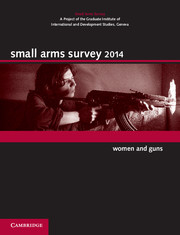Book contents
- Frontmatter
- Foreword
- Contents
- About the Small Arms Survey
- Notes to readers
- Acknowledgements
- Introduction
- Chapter 1 In War and Peace: Violence against Women and Girls
- Chapter 2 Converging Agendas: Women, Peace, Security, and Small Arms
- Special Feature. Women behind the Gun: Aiming for Equality and Recognition
- Chapter 3 Breaking New Ground?: The Arms Trade Treaty
- Chapter 4 Trade Update: Transfers, Retransfers, and the ATT
- Chapter 5 Countdown to Catastrophe: The Mpila Ammunition Depot Explosions
- Chapter 6 Across Conflict zones: Ammunition Profiling
- Chapter 7 Signs of Supply: Weapons Tracing in Sudan and South Sudan
- Chapter 8 On the Record: Illicit Weapons in the the United States
- Index
Chapter 4 - Trade Update: Transfers, Retransfers, and the ATT
Published online by Cambridge University Press: 05 July 2014
- Frontmatter
- Foreword
- Contents
- About the Small Arms Survey
- Notes to readers
- Acknowledgements
- Introduction
- Chapter 1 In War and Peace: Violence against Women and Girls
- Chapter 2 Converging Agendas: Women, Peace, Security, and Small Arms
- Special Feature. Women behind the Gun: Aiming for Equality and Recognition
- Chapter 3 Breaking New Ground?: The Arms Trade Treaty
- Chapter 4 Trade Update: Transfers, Retransfers, and the ATT
- Chapter 5 Countdown to Catastrophe: The Mpila Ammunition Depot Explosions
- Chapter 6 Across Conflict zones: Ammunition Profiling
- Chapter 7 Signs of Supply: Weapons Tracing in Sudan and South Sudan
- Chapter 8 On the Record: Illicit Weapons in the the United States
- Index
Summary
INTRODUCTION
Given the complex dynamics of the small arms trade, the impact of the Arms Trade Treaty (ATT) is difficult to predict. Yet this chapter, building on the considerable advances made in our understanding of the small arms trade in recent years, examines some of the factors that will determine the treaty's future impact on transfers, retransfers, and transparency. After reviewing the main actors of the authorized trade and global trends from 2001 to 2011, using the United Nations Commodity Trade Statistics Database (UN Comtrade), the chapter considers some of the possibilities—and opportunities—the ATT offers for addressing unauthorized retransfers. One of the main purposes of the ATT is to increase transparency in the international arms trade. After presenting the 2014 edition of the Transparency Barometer, this chapter reflects on how the ATT can build upon existing instruments to achieve this goal.
The main findings of the chapter include:
In 2011, the top exporters of small arms and light weapons (those with annual exports of at least USD 100 million), according to available customs data, were (in descending order) the United States, Italy, Germany, Brazil, Austria, Switzerland, Israel, the Russian Federation, South Korea, Belgium, China, Turkey, Spain, and the Czech Republic.
In 2011, the top importers of small arms and light weapons (those with annual imports of at least USD 100 million), according to available customs data, were (in descending order) the United States, Canada, Germany, Australia, Thailand, the United Kingdom, France, and Italy.
- Type
- Chapter
- Information
- Small Arms Survey 2014Women and Guns, pp. 108 - 143Publisher: Cambridge University PressPrint publication year: 2014



